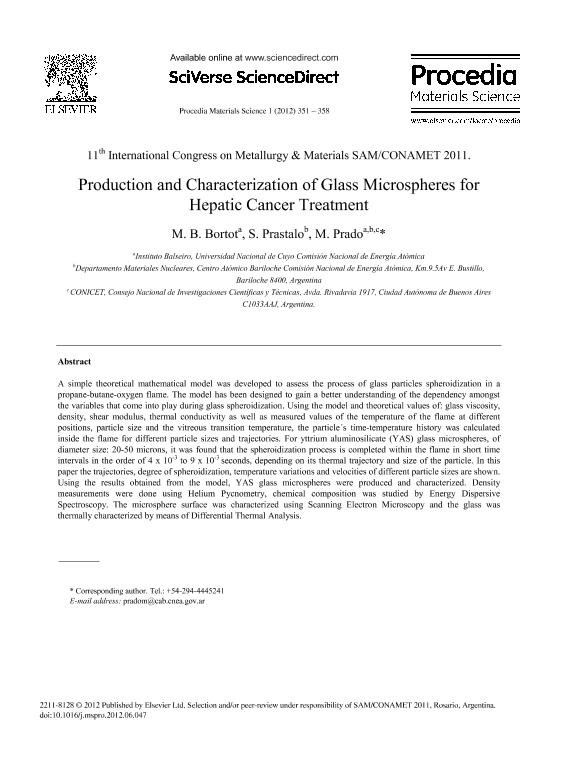Artículo
Production and Characterization of Glass Microspheres for Hepatic Cancer Treatment
Fecha de publicación:
01/2012
Editorial:
Elsevier Science
Revista:
Procedia Materials Science
ISSN:
2211-8128
Idioma:
Inglés
Tipo de recurso:
Artículo publicado
Clasificación temática:
Resumen
A simple theoretical mathematical model was developed to assess the process of glass particles spheroidization in a propane-butane-oxygen flame. The model has been designed to gain a better understanding of the dependency amongst the variables that come into play during glass spheroidization. Using the model and theoretical values of: glass viscosity, density, shear modulus, thermal conductivity as well as measured values of the temperature of the flame at different positions, particle size and the vitreous transition temperature, the particle«s time-temperature history was calculated inside the flame for different particle sizes and trajectories. For yttrium aluminosilicate (YAS) glass microspheres, of diameter size: 20-50 microns, it was found that the spheroidization process is completed within the flame in short time intervals in the order of 4 x 10-3 to 9 x 10-3 seconds, depending on its thermal trajectory and size of the particle. In this paper the trajectories, degree of spheroidization, temperature variations and velocities of different particle sizes are shown. Using the results obtained from the model, YAS glass microspheres were produced and characterized. Density measurements were done using Helium Pycnometry, chemical composition was studied by Energy Dispersive Spectroscopy. The microsphere surface was characterized using Scanning Electron Microscopy and the glass was thermally characterized by means of Differential Thermal Analysis.
Palabras clave:
Spheroidization
,
Yttrium Aluminosilicate Glass
,
Glass Microspheres
Archivos asociados
Licencia
Identificadores
Colecciones
Articulos(CCT - PATAGONIA NORTE)
Articulos de CTRO.CIENTIFICO TECNOL.CONICET - PATAGONIA NORTE
Articulos de CTRO.CIENTIFICO TECNOL.CONICET - PATAGONIA NORTE
Citación
Bortot, M. B.; Prastalo, S.; Prado, Miguel Oscar; Production and Characterization of Glass Microspheres for Hepatic Cancer Treatment; Elsevier Science; Procedia Materials Science; 1; 1-2012; 351-358
Compartir
Altmétricas




